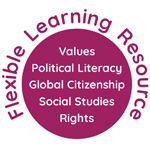Research question:
To what extent will cooperation bring peace to the daily lives of Israelis and Palestinians?
Resources Levels 3-4
Core Activities
- conflict-and-co-operation-presentation
- Perspective cartoon-perspective
- Security and Life in the Occupied Palestinian Territories
-
- Worksheet
- Walled Horizons film (8 mins)
- israeli-perspective-on-security information sheet 5
- The Prohibition Game (press CC for English Subtitles)
- Glossary Building word-match
- Cooperation
- tale-of-two-donkeys-cooperation
- Hand in Hand school information
- Hand and Hand school community speaks out against war – film (9 mins)
- Assessment word clouds.
Extension Activities
- boundaries-and-events
- The British in Palestine film
- Kites are Flying Michael Morpurgo book and worksheet
Notes on Core Activities
Activity one: Lesson one: This lesson is based on a presentation to build learners understanding of what conflict and cooperation look like in a general sense. The PowerPoint has questions throughout which will provide opportunities for learners to discuss their learning with each other.
Activity two: Perspective. If I disagree with you that doesn’t always mean that one of us is wrong, we may simply be looking at it from two different points of view. Learners examine the cartoon and consider what it means to them. They identify a situation where there are two different perspectives both of which can be seen as right from a particular point of view and consider how agreement can be reached where both sides win. It should be made clear that there are also times when one or both perspectives are not founded on reality and that truth lies elsewhere.
Activity three: Use Teaching Divided Histories resource to consider international conflict and cooperation.
Activity four: One Voice is an international movement that amplifies the voice of mainstream Israelis and Palestinians. From their film, Solutions Not Sides, students learn about the history of the current conflict from different points of view. The answer sheet can be the basis for discussion. A Newsround link contains 4 film clips: Why are Israeli’s and Palestinians fighting over Gaza? produced by the BBC early in the 2014 Gaza War; Israel’s Recognition a BBC introduction to establishment of the State of Israel; a map of the region; Life in Gaza and Children of the Gaza War BBC documentaries show what life is like for children living in Gaza and how children from both communities were affected by the war and UNICEF’s Children Living in Gaza’s Rubble, show the situation 1 year after the war ended.
Activity five: Security and Life in the Occupied Palestinian Territories. Learners watch the film, Walled Horizons from the UN Office for the Coordination of Humanitarian Affairs, taking notes as they watch then discussing what they have learned from the film. They read the Israeli perspective on security and discuss the barrier from the Israeli point of view and then complete a table to show differing perspectives. From Grove to Market is a resource from Oxfam showing Palestinians working together to bring in the olive harvest. A short animation, The Prohibition Game, shows the effect of the barrier on the livelihoods of Palestinians.
Activity six: Match words and build a glossary of key terms.
Activity seven: Learners first consider what cooperation means by reading and discussing the Tale of Two Donkeys. They read the information about Hand in Hand schools and watch a short film where the Hand and Hand school community speak about war and peace. Write a letter to a friend telling them about Hand and Hand and what the people in the film feel about conflict and peace in their land.
Activity eight: Assessment activity. Learners make two word clouds of words they associate with the history of Palestine and Israel and living today in the Occupied Palestinian Territories. Bigger words indicate the most important aspects.
Extension Activities
Activity one: working in groups, learners place the events and maps on a timeline and consider what questions they have about changes over time.
Activity two: It has been argued that events in the early part of the 20th century laid the foundations of the current conflict in Israel and Palestine. During this time the British had a big part to play in decision making. Students watch and discuss the film, The British in Palestine noting facts they have learned and questions they would like to ask. There could be a class discussion of the questions and research task for any unanswered questions.
Activity three: The novel The Kites are Flying by Michael Morpurgo is an appropriate accompaniment to this study. Amnesty have produced a worksheet for the novel.
